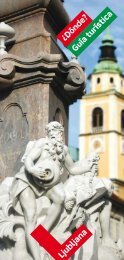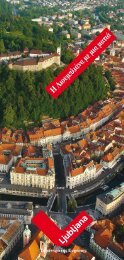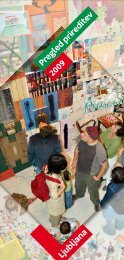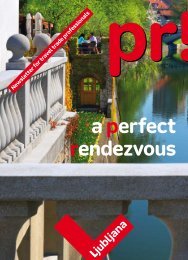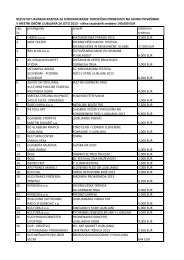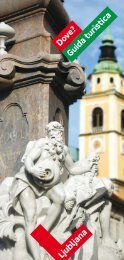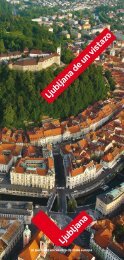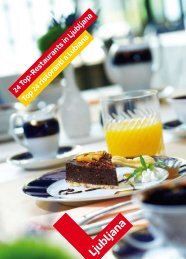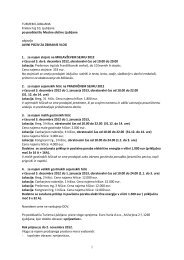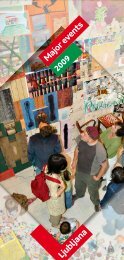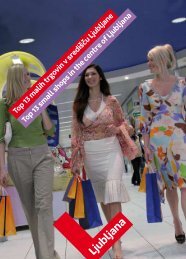English - Ljubljana
English - Ljubljana
English - Ljubljana
- No tags were found...
Create successful ePaper yourself
Turn your PDF publications into a flip-book with our unique Google optimized e-Paper software.
4<br />
Photo: R. Zakšek<br />
Europe Day in <strong>Ljubljana</strong><br />
On 8 May, the eve of Europe Day, which coincides with a red letter<br />
day in the history of <strong>Ljubljana</strong>, the Pogačarjev trg square will host<br />
an annual event entitled “From <strong>Ljubljana</strong> to Europe – From Europe<br />
to <strong>Ljubljana</strong>”. Well-known pieces of European classical music will<br />
be masterfully performed in a free concert presented to <strong>Ljubljana</strong><br />
audiences as a musical gift from the City of <strong>Ljubljana</strong> and the<br />
Representative Office of the European Commission in <strong>Ljubljana</strong>. This<br />
year, Europe Day celebrations will be joined by the Government of<br />
the Republic of Slovenia to mark the 60th anniversary of the Shuman<br />
Declaration. www.ec.europa.eu<br />
New Cultural Centre<br />
Španski borci<br />
The eastern part of <strong>Ljubljana</strong> now has a new<br />
cultural centre called Španski borci, which runs a<br />
programme of events in the fields of performing<br />
and visual arts, music, literature and humanities,<br />
including events for children and young people.<br />
Being a meeting point for artists from Slovenia and<br />
abroad and a platform for new art projects, it is a<br />
welcome new addition to <strong>Ljubljana</strong>’s cultural life.<br />
Emona – The Roman City of <strong>Ljubljana</strong><br />
Emona. A Roman colony. A city founded by Roman soldiers on the site of the present <strong>Ljubljana</strong> almost<br />
precisely two millenniums ago. What was Emona like and how did its residents live Who was it built<br />
and first inhabited by Which were the turning points in its history How were Emonians brought into<br />
the world, how did they get married, where did they shop, what did they believe in, and what did their<br />
homes look like Some of the answers to these questions can be found by simply taking a walk through<br />
<strong>Ljubljana</strong>. Those who want to learn more can visit the exhibition Emona: Myth and Reality, on view at the<br />
City Museum of <strong>Ljubljana</strong> from 18 May.<br />
Emona Model<br />
Photo: M. Paternoster<br />
residential house’s central<br />
heating system, among others.<br />
The Roman conquest of<br />
the greater <strong>Ljubljana</strong> area was<br />
part of the conquest of the<br />
Balkans during the time of<br />
Emperor Augustus. The colony<br />
Iulia Emona, established by<br />
the Romans in the 1st century<br />
on the site of the present city<br />
centre of <strong>Ljubljana</strong>, was the first<br />
proper city in central Slovenia.<br />
In the middle of the 6th century,<br />
after the decline of the Western<br />
Roman Empire, Emona was<br />
gradually abandoned and its<br />
more than 500-year history<br />
came to an end.<br />
Like other Roman cities,<br />
Emona was laid out according<br />
to a regular rectangular ground<br />
plan. It was surrounded by<br />
mighty city walls including 29<br />
towers and four main gates.<br />
The walls, 2.4 metres wide and<br />
from 6 to 8 metres high, had a<br />
perimeter of nearly 2 kilometres.<br />
The area inside the city<br />
walls was dissected by a grid<br />
of roads intersecting at a right<br />
angle to form vast building<br />
plots for residential purposes.<br />
Sewer channels known as<br />
cloacae, built alongside all the<br />
city’s roads running from west<br />
to east, discharged sewage<br />
into the Ljubljanica river. The<br />
city’s main square, the so called<br />
forum, which was built at the<br />
intersection of Emona’s two<br />
main roads, provided space for<br />
Emonians’ public social life.<br />
Emona within the present<br />
<strong>Ljubljana</strong><br />
Numerous remains of<br />
the city of Emona can still<br />
be found today if one takes<br />
Archeological Park Early<br />
Christian Palace of Worship<br />
Photo: M. Paternoster<br />
a walk through <strong>Ljubljana</strong>.<br />
The city’s Mirje area is the<br />
site of the southern part<br />
of the Roman town walls,<br />
renovated in the 1930 after<br />
a design by the architect<br />
Jože Plečnik. The statue of a<br />
wealthy Emonian standing in<br />
the Zvezda park is one of the<br />
most recognizable symbols of<br />
<strong>Ljubljana</strong>, next to the <strong>Ljubljana</strong><br />
Dragon. Reminiscences of<br />
Emona’s forum can be found<br />
in the Ferantov vrt residential<br />
complex, located by the<br />
Slovenska cesta road. Since the<br />
1960s and 1970s, which saw<br />
extensive excavations, <strong>Ljubljana</strong><br />
boasts two archaeological<br />
parks, which display an early<br />
Christian baptistery, a geometric<br />
floor mosaic, and an Emonian<br />
The life of Emonians<br />
From 18 May 2010 to the end<br />
of the year, the City Museum<br />
of <strong>Ljubljana</strong> will be showing<br />
an exhibition entitled Emona:<br />
Myth and Reality. The exhibition,<br />
accompanied by guided tours,<br />
lectures, film screenings and<br />
cooking workshops, will offer<br />
an opportunity to experience<br />
Emona mainly by exploring<br />
the aspects of its everyday life.<br />
Including interesting facts about<br />
Roman times, comparisons with<br />
life today, interactive displays,<br />
and stories about the life of<br />
Emonians, it will present both<br />
quotidian reality and the key<br />
turning points in the history of<br />
the Roman city of <strong>Ljubljana</strong>.<br />
www.mestnimuzej.si/en<br />
Urša Karer



